Last Updated on January 9, 2024 by Matt Greene
How far should you hit the ball?
How do you compare to others?
It's always good to know that age, gender, and skillset are the biggest differentiators so you don't make unrealistic comparisons.
I did so much research on this article to bring you the most up to date information to help you quickly skim the tables and charts about golf distance.
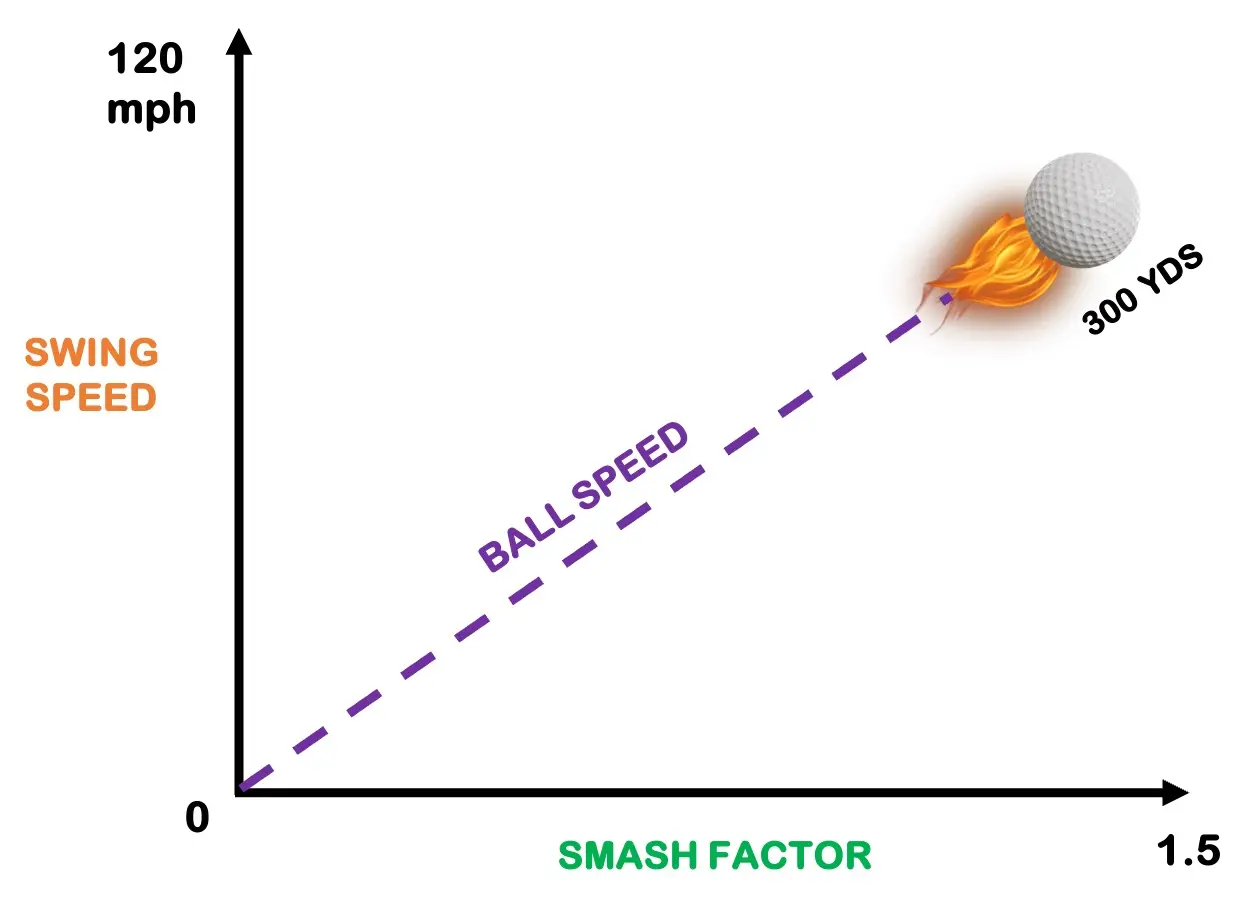
My golf distance charts show the key elements that influence how far you can hit each golf club:
- Swing speed
- Ball speed
- Smash factor
- Quality and optimization of equipment
These factors are all heavily influenced by your physiology, skill, age and strength or flexibility levels. Very often, you can optimize each area, with some training or coaching or both.
Golf Club Distance Chart by Swing Speed
Swing speed is a major determining factor the golf club distances. It is not the only factor but if 100 people strike the ball the same, the fastest swings will carry the ball further.
- Most golfers are around 90 mph driver swing speed.
- The average swing speed on the PGA Tour is around 114 mph.
- 150 mph is the top range and only long drive competitors will be swinging toward this range.
NOTE: The swing speed at the top of each column is driver swing speed. We use this as a general gauge to estimate the distance of each club thereafter.
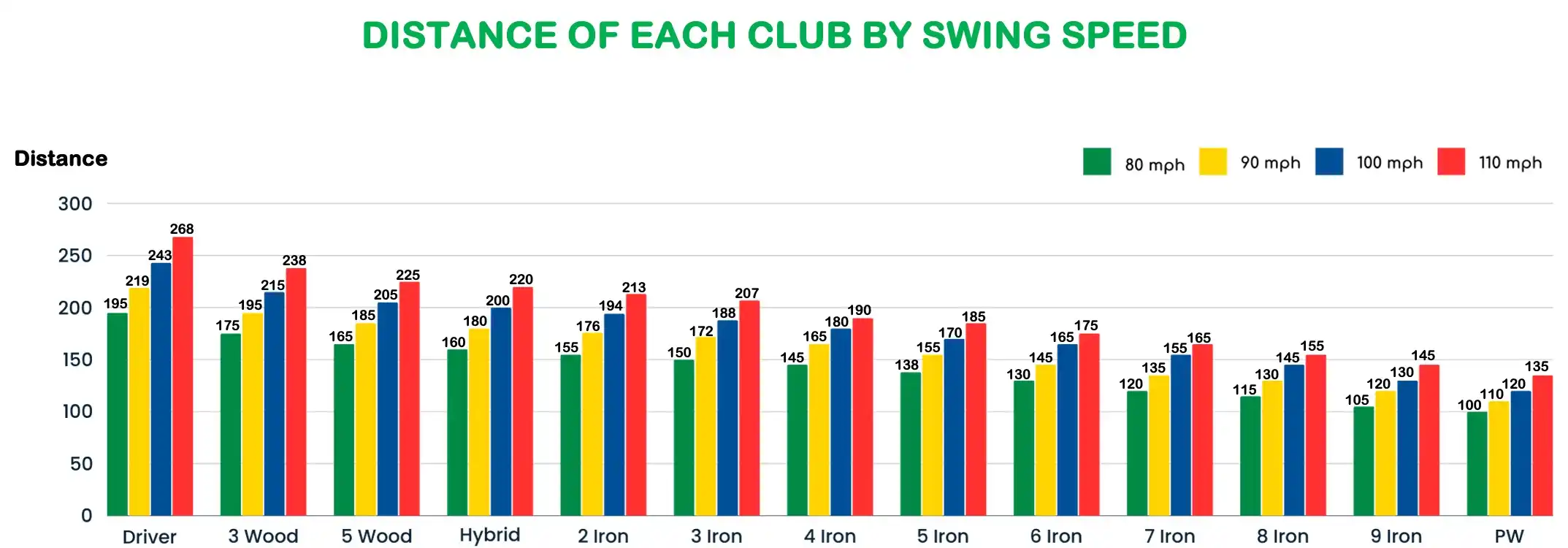
Club | 60 mph | 70 mph | 80 mph | 90 mph | 100 mph | 110 mph | 120 mph | 130 mph | 140 mph | 150 mph |
Driver (Total) | 155 | 181 | 206 | 232 | 258 | 284 | 310 | 335 | 361 | 385 |
Driver (Carry) | 146 | 170 | 195 | 219 | 243 | 268 | 292 | 316 | 340 | 365 |
3 Wood | 130 | 150 | 175 | 195 | 215 | 238 | 259 | 283 | 303 | 318 |
5 Wood | 125 | 145 | 165 | 185 | 205 | 225 | 245 | 265 | 285 | 305 |
Hybrid | 120 | 140 | 160 | 180 | 200 | 220 | 240 | 260 | 280 | 300 |
2 Iron | 118 | 135 | 155 | 176 | 194 | 213 | 233 | 252 | 271 | 292 |
3 Iron | 115 | 130 | 150 | 172 | 188 | 207 | 226 | 245 | 265 | 284 |
4 Iron | 110 | 126 | 145 | 165 | 180 | 190 | 208 | 226 | 245 | 264 |
5 Iron | 105 | 120 | 138 | 155 | 170 | 185 | 198 | 215 | 228 | 247 |
6 Iron | 100 | 115 | 130 | 145 | 165 | 175 | 185 | 195 | 208 | 219 |
7 Iron | 95 | 105 | 120 | 135 | 155 | 165 | 175 | 185 | 195 | 210 |
8 Iron | 85 | 100 | 115 | 130 | 145 | 155 | 165 | 175 | 190 | 202 |
9 Iron | 80 | 90 | 105 | 120 | 130 | 145 | 160 | 175 | 186 | 197 |
Pitching Wedge | 73 | 85 | 100 | 110 | 120 | 135 | 145 | 156 | 167 | 179 |
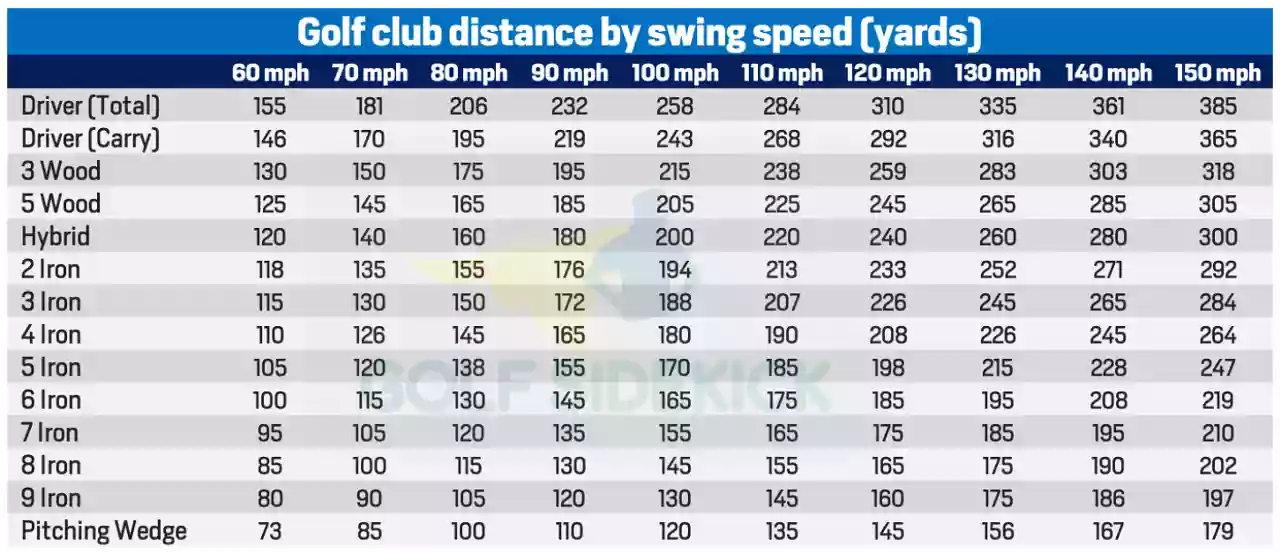
How do I swing the club faster?
You've compared yourself to the numbers in the chart but you want to hit it longer. Almost everyone does and there are 3 ways to swing the club faster:
- Get lessons on proper mechanics with a professional swing coach. They will utilize all your physiological elements and limitations to the maximum, as well as help you hit the ball in the center of the club face. You can add as much as 10 mph to your driver swing speed with correct technique.
- Get stronger and more mobile in the gym. Strength training plus mobility work with a trainer will increase your swing speed guaranteed. You will have a wider range of motion in your muscles and your strength will 100% translate into more speed. You can add 10-20mph to your swing depending on how advanced your strength and mobility currently is.
- Get lighter golf equipment fitted to your swing. Lighter shafts can help increase your swing speed 2-5 mph.
These are the only ways to improve swing speed but the MOST important factor is the coaching and practice so that you can HIT THE SWEET SPOT of the golf club.
The center strike means you send as much energy into the ball as possible and we measure how well you hit the ball using the Smash Factor.
What is Smash Factor?
Smash Factor is ball speed divided by club speed.
For example: 150 mph ball speed / 100 mph swing speed = 1.50 Smash Factor
The number calculated gives a ratio to show how much energy is moved from the club head to the golf ball at impact.
Low Smash Factor numbers mean less energy is transferred, while higher Smash Factor numbers mean you send more energy from your golf club into the golf ball.
The optimum Smash Factor number for excellent ball striking with the driver is 1.50 Smash Factor.
Ideal Smash Factor for every club
The PGA Tour golfers are the best in the world so we can use their averages to assume the best smash factors in the world. If you can attain these smash factor numbers as stated by Trackman, you are striking the ball as good as you possibly can.
Note how the smash factor decreases as the loft increases.
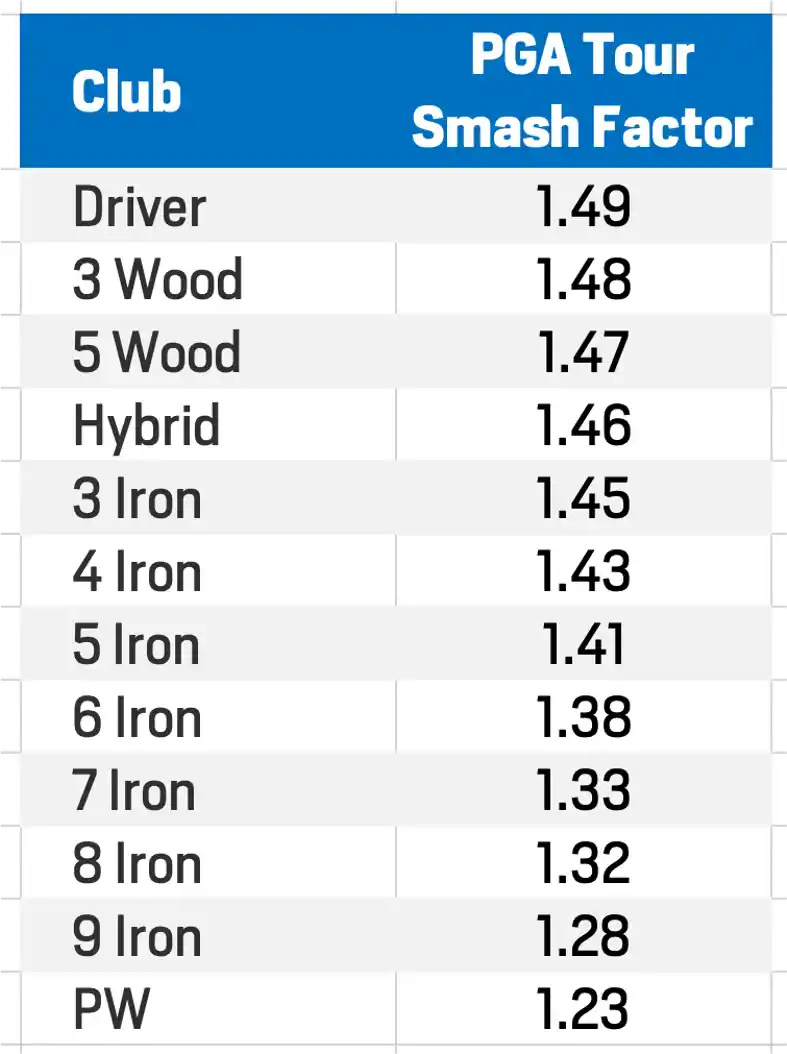
| Club | PGA Tour Smash Factor |
| Driver | 1.49 |
| 3 Wood | 1.48 |
| 5 Wood | 1.47 |
| Hybrid | 1.46 |
| 3 Iron | 1.45 |
| 4 Iron | 1.43 |
| 5 Iron | 1.41 |
| 6 Iron | 1.38 |
| 7 Iron | 1.33 |
| 8 Iron | 1.32 |
| 9 Iron | 1.28 |
| PW | 1.23 |
Skill level affects smash factor
Distance is affected by the swing speed but MAINLY the quality of the strike related to that swing speed.
In other words, how close to the center of the club face you hit the ball will determine how your swing speed power is transferred into the golf ball.
If you employ a swing coach, they will assist you in hitting the ball in the middle of the face, or closer to the middle.
That will take your existing swing speed and optimize it by being more efficient with where you hit the ball on the club.
The measurement we use for the quality of your strike is called Smash Factor.
Equipment affects swing speed and smash factor
The pros on tour have optimized equipment to their specific technique and skill level as well as body shape and strength.
The same swing speed in a PGA Tour pro will send the ball much further than an amateur golfer of higher handicap who has a similar swing speed.
The PGA Tour players technique is perfect so if you and a Tour pro hit the ball the same, the pro would still hit the ball further because their equipment has been customized to their exact swing.
A fitting can help to optimize your strength and swing for more distance.
Average Golf Club Distance For Male Golfers By Skill Level
From 'Good Golfer' onward, the 2 iron down to 5 iron should improve as confidence and technique improve, thus bringing more swing speed.
Beginner Golfer: New to the game - first 6-12 months.
Average Golfer: 15-24 handicap.
Good Golfer: 6-14 handicap.
Excellent Golfer: Below 6 handicap.
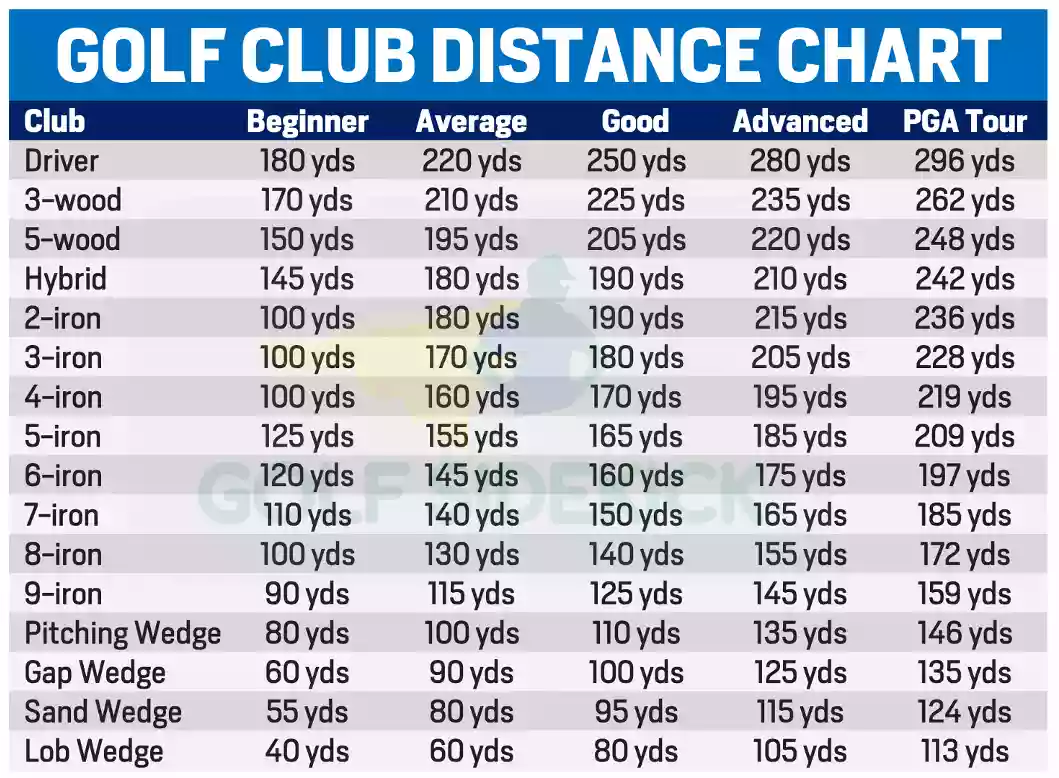
Club | Beginner | Average | Good | Excellent |
Driver | 180 yds | 220 yds | 250 yds | 280 yds |
3 Wood | 170 yds | 210 yds | 225 yds | 235 yds |
5 Wood | 150 yds | 195 yds | 205 yds | 220 yds |
Hybrid | 145 yds | 180 yds | 190 yds | 210 yds |
2 Iron | 100 yds | 180 yds | 190 yds | 215 yds |
3 Iron | 100 yds | 170 yds | 180 yds | 205 yds |
4 Iron | 100 yds | 160 yds | 170 yds | 195 yds |
5 Iron | 120 yds | 155 yds | 165 yds | 185 yds |
6 Iron | 120 yds | 145 yds | 160 yds | 175 yds |
7 Iron | 110 yds | 140 yds | 150 yds | 165 yds |
8 Iron | 100 yds | 130 yds | 140 yds | 155 yds |
9 Iron | 90 yds | 115 yds | 125 yds | 145 yds |
Pitching Wedge | 80 yds | 100 yds | 110 yds | 135 yds |
Gap Wedge | 60 yds | 90 yds | 100 yds | 125 yds |
Sand Wedge | 55 yds | 80 yds | 95 yds | 115 yds |
Lob Wedge | 40 yds | 60 yds | 80 yds | 105 yds |
Swing speed charts by age and gender
Swing speed is a vital factor in determining the distance you hit the ball.
The swing speed, with a strike near the middle of the club face makes the ball go further.
A poor strike with high swing speed will go less distance.
A pro golfer swinging at the same speed as an amateur gets wildly different distance numbers because they hit the ball in the center of the face often.
Therefore, if you want to improve your distance with the same swing speed, you can work on improving your strike closer to the middle of the face.
Average swing speed by age and gender chart
In this chart we show the 50th percentile driver swing speed for each gender and age range according to the research done by TPI.
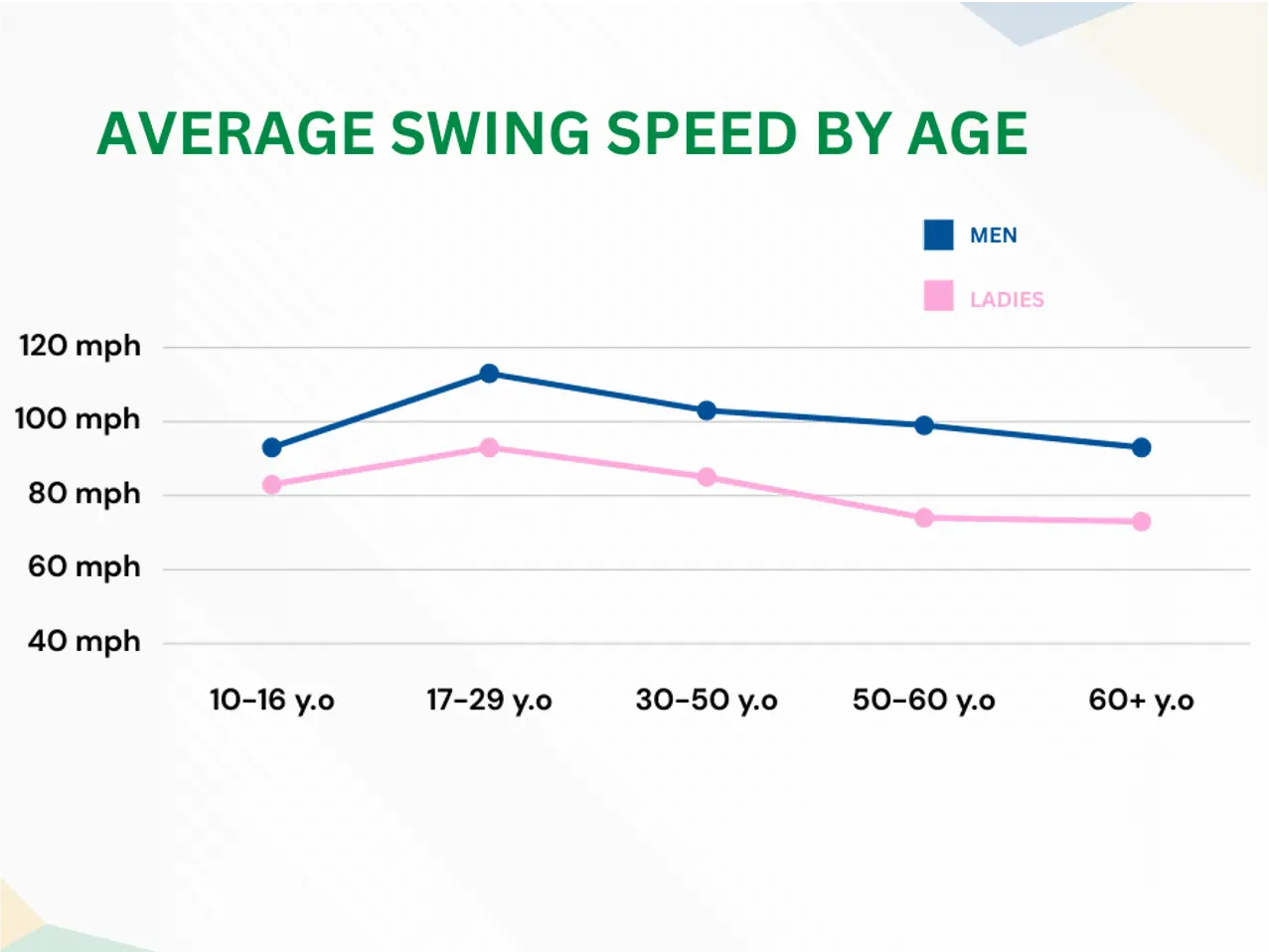
| Age | Men | Women |
| 10-16 years old | 93 mph | 83 mph |
| 17-29 years old | 113 mph | 93 mph |
| 30-50 years old | 103 mph | 85 mph |
| 50-60 years old | 99 mph | 74 mph |
| 60+ years old | 93 mph | 73 mph |
Driver Swing Speed Chart by Golf Skill Level
Confidence and skill make a big difference when hitting the driver efficiently and out the sweet spot.
Beginners with a driver will be more tentative and have less effective mechanics.
Mid handicappers will be more adept at the driver because of experience or lessons.
Advanced golfers swing with confidence from hitting a lot of golf balls and taking lessons with a pro.
PGA Tour golfers have optimized every aspect of the game with the driver and are the very tip of the spear.
| Skill Level | Swing Speed | Driver Distance |
| Beginner | 80 mph | 190 yards |
| Average | 94 mph | 220 yards |
| Good | 100 mph | 240 yards |
| Excellent | 110 mph | 265 yards |
| PGA Tour Average | 114 mph | 275 yards |
| Women’s Average | 77 mph | 180 yards |
| LPGA Tour Average | 94 mph | 218 yards |
Is a 250 yard drive good?
Yes it is very good. According to Arccos and Shotscope, between 15% and 31% of golfers hit 250 yards or more.
Here is a video of me breaking it down.
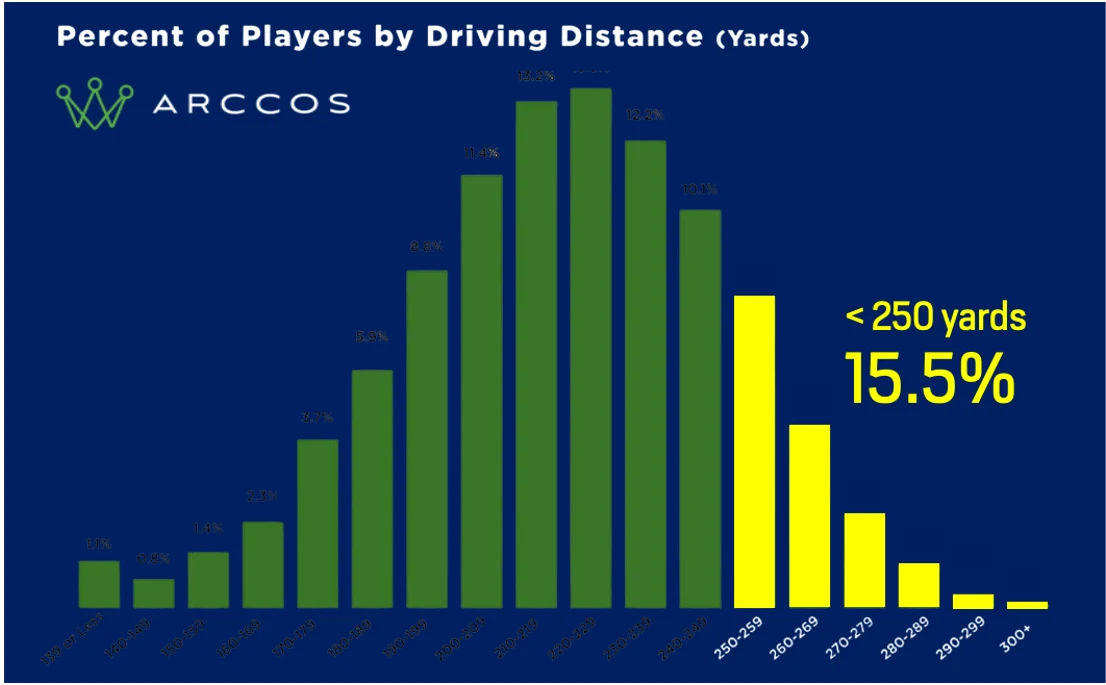
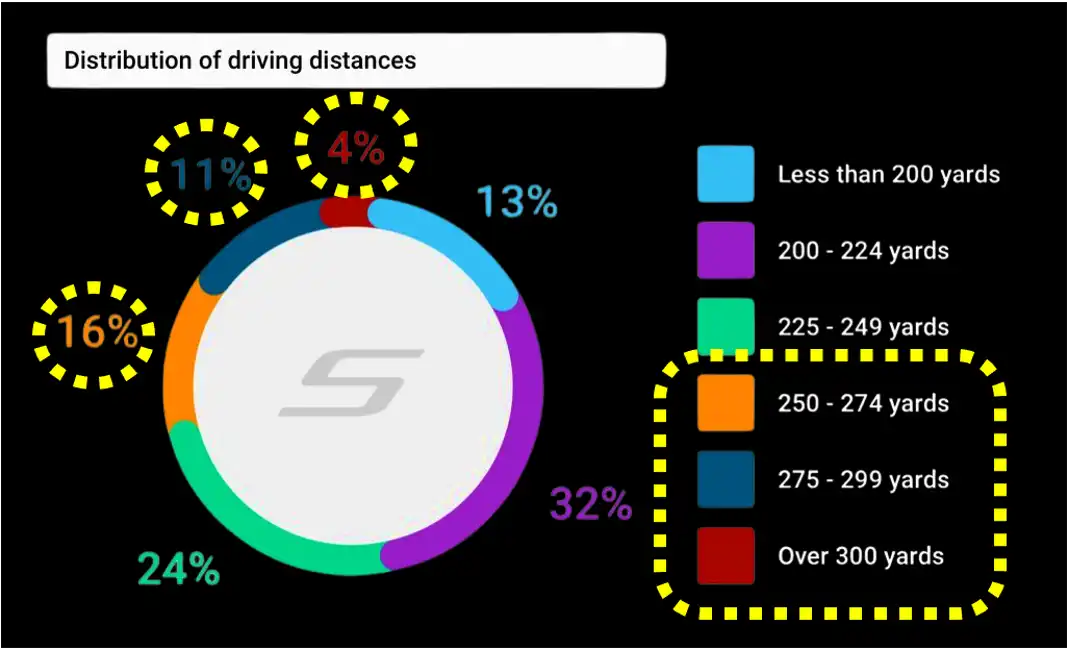
Ball Speed To Club Head Speed Chart for Driver
The ball speed off the driver face is dependent on the strike.
If your strike or Smash Factor is good, you will hit the ball further with your swing speed than the same speed with a bad strike.
Below, we take the club head speed and use a Smash Factor of around 1.42 which is 0.08 away from a perfect strike.
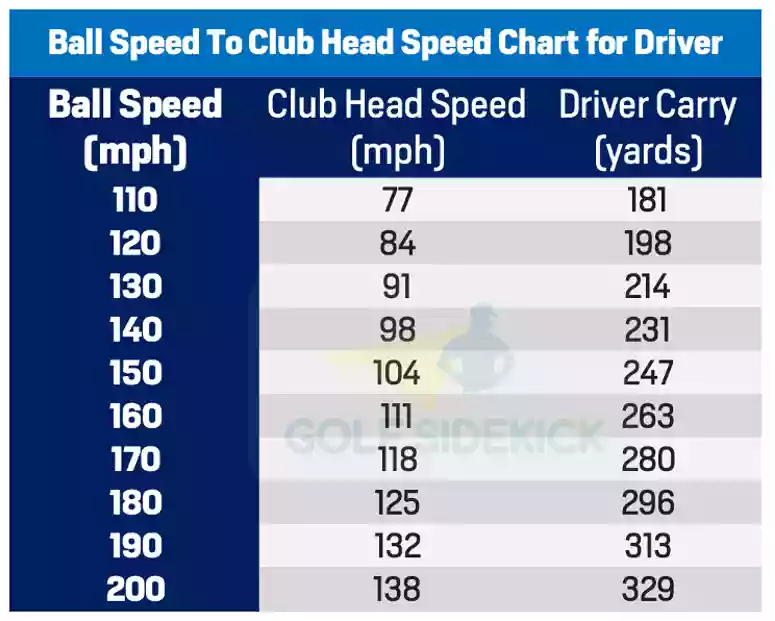
Ball Speed (mph) | 110 | 120 | 130 | 140 | 150 | 160 | 170 | 180 | 190 | 200 |
Club Head Speed (mph) | 77 | 84 | 91 | 98 | 104 | 111 | 118 | 125 | 132 | 138 |
Driver Carry | 181 | 198 | 214 | 231 | 247 | 263 | 280 | 296 | 313 | 329 |
What swing speed hits 250 yard drives?
A swing speed of around 105 mph with the driver, and ball speed of around 150 mph will produce a 250 yard drive.
Ball Speed To Club Head Speed for 7 iron
A 7 iron optimal smash factor is 1.33. That is the PGA Tour average. Remember for the driver it is 1.50
The ball speed off the 7 iron is determined by the swing speed and smash factor.
As the clubs get shorter, the ideal smash factor actually changes.
What distance will you get from a 7 iron at every speed of swing?
7 iron distance by driver swing speed | |
Swing speed | Distance |
| 60 mph | 95 yards |
| 70 mph | 105 yards |
| 80 mph | 120 yards |
| 90 mph | 135 yards |
| 100 mph | 155 yards |
| 110 mph | 165 yards |
| 120 mph | 175 yards |
| 130 mph | 185 yards |
| 140 mph | 195 yards |
| 150 mph | 210 yards |
What swing speed hits the 7 iron 150 yards?
A swing speed of around 76 mph with the 7 iron, ball speed of around 105 mph and dynamic loft of 21° will produce a 150 yard carry shot.
Golf Club Distance Charts Other Important Factors
Loft
Every club has a different loft and more loft goes less distance, while less loft goes longer distance in combination with longer golf shafts.
Driver usually goes furthest while the lob wedge around 60 degrees goes the shortest.
Clubs | Average Lofts 2022 | Average Lofts 1990 |
Driver | 8° – 13° | 9° – 14° |
3 Wood | 13° – 15° | 15° – 17° |
5 Wood | 20° – 23° | 21° – 24° |
2 Iron | 18° – 20° | 20° – 22° |
3 Iron | 21° – 24° | 23° – 25° |
4 iron | 25° – 28° | 28° – 30° |
5 iron | 28° – 31° | 31° – 33° |
6 iron | 32° – 35° | 35° – 37° |
7 iron | 36° – 38° | 39° – 41° |
8 iron | 40° – 43° | 43° – 47° |
9 iron | 45° – 48° | 48° – 50° |
Pitching Wedge | 47° – 50° | 51° – 54° |
The golf clubs of today go a lot further since the manufacturers started creating cavity back golf clubs in combination with lower lofts for the same clubs.
Every club is between 2 and 5 degrees lower in loft in the current day, which automatically increases distance by up to 15 yards per iron compared to prior times. Driver lofts cannot get much lower as people will not be able to hit them. In order to hit a driver with a loft below 9 degrees, your swing speed needs to be incredibly fast.
An important factor to note for slower swing speeds, is that a higher lofted fairway wood or higher lofted driver can actually GAIN you distance because low lofted clubs are harder to launch at slower swings. Most golfers should be playing fairway woods with a loft that does not go below 16 or 17 degrees.
The club heads are bigger for all golf clubs in modern times with much larger sweet spots. With the addition of lighter shafts in both the irons and the woods, the ball speeds and swing speeds are higher as well. Check out our article on the flex of shafts in the current game.
Golf Club Distance Charts of PGA Tour Golfers
Club | PGA TOUR Average | Bryson De Chambeau | Dustin | Rory McIlroy | Tiger | Jack | LPGA Tour Averages |
Driver | 275 | 325 | 312 | 360 | 297 | 250 | 255 |
3 Wood | 243 | 295 | 282 | 325 | 265 | 235 | 230 |
5 Wood | 230 | 275 | 267 | 300 | 245 | 220 | 215 |
3 Iron | 212 | – | – | – | 227 | 210 | 197 |
4 Iron | 203 | 255 | 236 | 272 | 215 | 195 | 186 |
5 Iron | 194 | 235 | 225 | 256 | 200 | 180 | 175 |
6 Iron | 183 | 220 | 212 | 235 | 186 | 167 | 164 |
7 Iron | 172 | 205 | 200 | 222 | 170 | 155 | 153 |
8 Iron | 160 | 190 | 186 | 200 | 157 | 145 | 142 |
9 Iron | 148 | 175 | 172 | 188 | 148 | 130 | 130 |
Pitching Wedge | 136 | 160 | 158 | 169 | 136 | 120 | 118 |
Why are modern golfers longer than prior generations?
Physical fitness
Most modern pros are in the gym multiple times per week and in the physio offices often. In prior generations during the Arnold Palmer and Jack Nicklaus days, the pros were regular people who even used to enjoy a smoke and a drink on the course.
Bryson Dechambeau is an example of someone who bulked up in order to hit it further and it made a big difference. The side effects of that can be disputed as he has slimmed down again.
Tiger Woods was one of the first modern day pros to begin working in the gym. His huge transformation to a big, strong guy inspired a whole new generation of golfers and now most up and coming pros are hitting the ball longer than even this generation of pros.
Club advancements
Lofts have changed and the lower lofts in irons will change how far the ball appears to go with the same 'number' iron.
A 7 iron from the 80s may have had 40° of loft while a current 7 iron can have as low as 28° of loft. That 12 degree difference makes a 20-30 yard difference in distance.
The other important factor especially with the woods and drivers, is the materials of the clubs. The drivers now are lightweight titanium and carbon, with graphite shafts, optimized for huge distance.
That alone makes an astonishing difference when we compare to the old persimmon wooden clubs and heavy steel shafts.
Golf Ball
The golf ball changed a lot with the release of the Pro V1. Golf balls just went further than ever before.
They spin less, they go straighter and they have advanced to a point that the ruling authorities of golf want to make them go shorter to preserve the golf courses.
If the pros hit the ball too long, they need to extend the golf courses, and there is a lkmited amount fo land available.
The balata golf ball is significantly shorter than the current urethane covered solid core golf balls they use today on the Tour.
Conclusion
You can compare how you shape up against the average golfer, the senior golfer, the pro golfer and the advanced golfer.
The key though is to understand your own game and your distances so you can more effectively plan your game and piece together a good golf score. When you fully understand and accept your distances that you hit the golf ball, you will score better.
For the pros and the advanced players, the distance they hit each club is not a matter of ego. It's a matter of 'which club gets the job done?' and they use that.
You can too, whichever distance you hit it.
